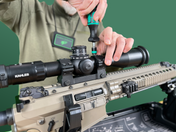MCX of the SEK-Berlin
The intuitive operation enables a quick transfer to operational readiness
Berlin-based Andres Industries AG has won several tenders for night vision/thermal imaging goggles and targeting devices for the Berlin police. The first devices are currently being delivered. Devices from the TigIR and PumIR series for mounting on weapons, as well as TILO for attachment to the helmet for use as thermal imaging goggles, were purchased for a wide variety of purposes.
For the first time, the PumIR series is being used in large numbers. The device is characterized by the fact that it can also be used in front of a reflex sight, both with and without a downstream magnifier. It is also possible to increase the detection range from 2000m to 4000m using the optional upstream afocal lens, without having to correct the offset.
PumIR with the 2x attachment lens increases the range to up to 4km.
The Berlin-based company not only develops the devices in the German capital, but also manufactures them locally. There is an intensive exchange between users and developers, which is an important prerequisite for the company's innovative product developments. The company's thermal imaging technology is considered to be leading in terms of its compactness and low weight, both in the military and in special police units.
In rain and fog
As the thermal resolution increases, the image quality and detection range improve significantly. The latest variants of TigIR, TILO, and PumIR have a thermal resolution of <15mK, which provides particular advantages in poor visibility conditions. This makes them unique in the Western military alliance system.
Night vision technology is also supplied
The particularly light (93g) and stable bridge was developed for the Berlin SEK.
Here, the Berlin SEK relies on flexibility and equipment for all emergency forces. The suppliedMini-14 monoculars can be connected to a particularly light bridge for binocular use, which offers considerable advantages in use, especially when it comes to orientation in narrow interior spaces, as three-dimensional vision is possible.







